Characterization and Life Cycle Exergo-Environmental Analysis of Wood Pellet Biofuel Produced in Khyber Pakhtunkhwa, Pakistan
Abstract
1. Introduction
2. Materials and Methods
2.1. Study Area
2.2. Goal and Scope Definition
2.2.1. Data Collection
2.3. Life Cycle Inventory
2.4. Life Cycle Impact Assessment
2.5. Interpretation
2.6. Characterization of Wood Pellets Biofuel
2.6.1. Moisture
2.6.2. Dimensions
2.6.3. Bulk Density
2.6.4. Ash Content
2.6.5. Heating Values
2.6.6. Elemental Analysis
3. Results and Discussions
3.1. Environmental Impacts Assessment of Pellets Biofuel
3.2. Damage Assessment of Pellets Biofuel
3.3. Single Score Damage Assessment
3.4. Cumulative Exergy Demand of Pellet Biofuel
3.5. Single Score Exergy
3.6. Wood Pellets Biofuel Characterization
3.6.1. Dimensions
3.6.2. Moisture Content
3.6.3. Ash Content
3.6.4. Bulk Density
3.6.5. Heating Values
3.6.6. Nitrogen and Sulphur Content
3.7. Discussion
3.8. Sensitivity Analysis for Wood Pellets
4. Conclusions and Recommendations
Author Contributions
Funding
Institutional Review Board Statement
Informed Consent Statement
Data Availability Statement
Acknowledgments
Conflicts of Interest
Ethical Statement
References
- Andreev, K.; Kantorová, V.; Bongaarts, J. Demographic Components of Futurepopulation Growth; Technical Paper No. 2013/3; United Nations Department of Economic and Social Affairs: New York, NY, USA, 2013. [Google Scholar]
- Heinimö, J.; Junginger, M. Production and trading of biomass for energy–an overview of the global status. Biomass Bioenergy 2009, 33, 1310–1320. [Google Scholar] [CrossRef]
- Orkustofnun, G. 2’s United Nations. Geothermal Training in Iceland: Reports of the United Nations University Geothermal Training Programme in 2009, 12179. Available online: https://sustainabledevelopment.un.org/content/documents/3337energy_georgsson.pdf (accessed on 17 August 2021).
- Martins, F.; Felgueiras, C.; Smitkova, M.; Caetano, N. Analysis of fossil fuel energy consumption and environmental impacts in European countries. Energies 2019, 12, 964. [Google Scholar] [CrossRef]
- Artemio, C.P.; Maginot, N.H.; Serafín, C.U.; Rahim, F.; Guadalupe, R.Q.J.; Fermín, C.M.; García, R. Characterization of Spanish biomass wastes for energy use. Bioresour. Technol. 2012, 103, 249–258. [Google Scholar]
- El Bassam, N.; Maegaard, P. Integrated Renewable Energy for Rural Communities: Planning Guidelines, Technologies and Applications; Elsevier: Amsterdam, The Netherlands, 2004. [Google Scholar]
- De Almeida, R.S.; Klotzle, M.C.; Pinto, A.C.F. Composição do conselho de Administração no setor de energia elétrica do Brasil. Rev. Adm. UNIMEP 2013, 11, 156–180. [Google Scholar] [CrossRef][Green Version]
- Fantozzi, F.; Buratti, C. Life cycle assessment of biomass chains: Wood pellet from short rotation coppice using data measured on a real plant. Biomass Bioenergy 2010, 34, 1796–1804. [Google Scholar] [CrossRef]
- Gil, M.V.; Casal, D.; Pevida, C.; Pis, J.J.; Rubiera, F. Thermal behaviour and kinetics of coal/biomass blends during co-combustion. Bioresour. Technol. 2010, 101, 5601–5608. [Google Scholar] [CrossRef]
- Munir, S.; Daood, S.S.; Nimmo, W.; Cunliffe, A.M.; Gibbs, B.M. Thermal analysis and devolatilization kinetics of cotton stalk, sugar cane bagasse and shea meal under nitrogen and air atmospheres. Bioresour. Technol. 2009, 100, 1413–1418. [Google Scholar] [CrossRef] [PubMed]
- Li, Z.; Zhao, W.; Li, R.; Wang, Z.; Li, Y.; Zhao, G. Combustion characteristics and NO formation for biomass blends in a 35-ton-per-hour travelling grate utility boiler. Bioresour. Technol. 2009, 100, 2278–2283. [Google Scholar] [CrossRef] [PubMed]
- Qian, F.P.; Chyang, C.S.; Huang, K.S.; Tso, J. Combustion and NO emission of high nitrogen content biomass in a pilot-scale vortexing fluidized bed combustor. Bioresour. Technol. 2011, 102, 1892–1898. [Google Scholar] [CrossRef] [PubMed]
- Demirbas, A. Importance of biomass energy sources for Turkey. Energy Policy 2008, 36, 834–842. [Google Scholar] [CrossRef]
- Bahng, M.K.; Mukarakate, C.; Robichaud, D.J.; Nimlos, M.R. Current technologies for analysis of biomass thermochemical processing: A review. Anal. Chim. Acta 2009, 651, 117–138. [Google Scholar] [CrossRef] [PubMed]
- FAO. 2017. Available online: http://www.fao.org/faostat/en/#data (accessed on 7 January 2018).
- Purohit, P.; Chaturvedi, V. Biomass pellets for power generation in India: A techno-economic evaluation. Environ. Sci. Pollut. Res. 2018, 25, 29614–29632. [Google Scholar] [CrossRef] [PubMed]
- WBA. Pellets a Fast-Growing Energy Carrier; World Bioenergy Association: Stockholm, Sweden, 2014. [Google Scholar]
- Dwivedi, P.; Khanna, M.; Bailis, R.; Ghilardi, A. Potential greenhouse gas benefits of transatlantic wood pellet trade. Environ. Res. Lett. 2014, 9, 024007. [Google Scholar] [CrossRef]
- Sikkema, R.; Steiner, M.; Junginger, M.; Hiegl, W.; Hansen, M.T.; Faaij, A. The European wood pellet markets: Current status and prospects for 2020. Biofuels Bioprod. Biorefining 2011, 5, 250–278. [Google Scholar] [CrossRef]
- Hanssen, S.V.; Duden, A.S.; Junginger, M.; Dale, V.H.; van der Hilst, F. Wood pellets, what else? Greenhouse gas parity times of European electricity from wood pellets produced in the south-eastern United States using different softwood feedstocks. Gcb Bioenergy 2017, 9, 1406–1422. [Google Scholar] [CrossRef]
- Prestemon, J.P.; Wear, D.N.; Foster, M.O. The Global Position of the US Forest Products Industry; e-Gen. Technical Report SRS-204; US Department of Agriculture Forest Service, Southern Research Station: Asheville, NC, USA, 2015; Volume 204, 24p.
- Hoefnagels, R.; Junginger, M.; Faaij, A. The economic potential of wood pellet production from alternative, low-value wood sources in the southeast of the US. Biomass Bioenergy 2014, 71, 443–454. [Google Scholar] [CrossRef]
- Abt, K.L.; Abt, R.C.; Galik, C.S.; Skog, K.E. Effects of Policies on Pellet Production and Forests in the US South: A Technical Document Supporting the Forest Serviceupdate of the 2010 RPA Assessment; US Department of Agriculture Forest Service, Southern Research Station: Asheville, NC, USA, 2014; Volume 202, 33p.
- Fantozzi, F.; Barbanera, M.; Buratti, C. Life cycle analysis of wood pellet from SRC through direct measuring of energy consumption. In Proceeding of 14th European Biomass Conference and Exibition, Biomass for Energy, Industry and Climate Protection, Paris, France, 17–21 October 2005. [Google Scholar]
- Maraver, G.; Carpio, M.; Factors Affecting Pellet Quality. WIT Transactions on State of the Art in Science and Engineering; WIT Press: Southampton, UK, 2022; Volume 85. [Google Scholar] [CrossRef]
- Ullah, M.; Mehmood, S.; Ali, M.; Bussmann, R.W.; Aldosari, A.; Khan, R.A.; Ullah, R.; Hussain, W.; Shah, M.A.R. An ethnopharmacological study of plants used for treatment of diabetes in the Southern and Tribal regions of Khyber Pakhtunkhwa province, Pakistan. Ethnobot. Res. Appl. 2019, 18, 1–20. [Google Scholar] [CrossRef]
- Bakhtullah, F.P.; Shahid, M.; Basit, A.; Khan, M.A.; Gul, S.; Wazir, I.; Raqeebullah, K.R. Sero–prevalence of brucellosis in cattle in southern area of Khyber Pakhtunkhwa, Pakistan. Res. J. Vet. Pract. 2014, 2, 63–66. [Google Scholar]
- Khan, R. Facts about AZRI; Pakistan Agricultural Research Council, Arid Zone Research Institute Ratta Kulachi: DI Khan, Pakistan, 2003; pp. 2–4.
- Ullah, M.; Khan, M.U.; Mahmood, A.; Malik, R.N.; Hussain, M.; Wazir, S.M.; Daud, M.; Shinwari, Z.K. An ethnobotanical survey of indigenous medicinal plants in Wana district south Waziristan agency, Pakistan. J. Ethnopharmacol. 2013, 150, 918–924. [Google Scholar] [CrossRef]
- Hamid, A.; Mahmood, T.; Fatima, H.; Hennelly, L.M.; Akrim, F.; Hussain, A.; Waseem, M. Origin, ecology and human conflict of gray wolf (Canis lupus) in Suleman Range, South Waziristan, Pakistan. Mammalia 2019, 83, 539–551. [Google Scholar] [CrossRef]
- Hussain, M.; Malik, R.N.; Taylor, A. Carbon footprint as an environmental sustainability indicator for the particleboard produced in Pakistan. Environ. Res. 2017, 155, 385–393. [Google Scholar] [CrossRef] [PubMed]
- International Organization for Standardization. Environmental Management: Life Cycle Assessment; Principles and Framework; ISO: Geneva, Switzerland, 2006; Volume 14044. [Google Scholar]
- Adams, P.; Shirley, J.; McManus, M. Comparative cradle-to-gate life cycle assessment of wood pellet production with torrefaction. Appl. Energy 2015, 138, 367–380. [Google Scholar] [CrossRef]
- Kouchaki-Penchah, H.; Sharifi, M.; Mousazadeh, H.; Zarea-Hosseinabadi, H. Life cycle assessment of medium-density fiberboard manufacturing process in Islamic Republic of Iran. J. Clean. Prod. 2016, 112, 351–358. [Google Scholar] [CrossRef]
- Adams, P.; McManus, M. Small-scale biomass gasification CHP utilisation in industry: Energy and environmental evaluation. Sustain. Energy Technol. Assess. 2014, 6, 129–140. [Google Scholar] [CrossRef]
- Testing of Solid Fuels, Compressed Untreated Wood. Requirements and Testing; DIN 51731; German Institute for Standardisation: Berlin, Germany, 1996.
- Nzihou, J.F.; Hamidou, S.; Bouda, M.; Koulidiati, J.; Segda, B.G. Using Dulong and Vandralek formulas to estimate the calorific heating value of a household waste model. Int. J. Sci. Eng. Res. 2014, 5, 1878–1883. [Google Scholar]
- Alakangas, E. European Standard (EN 14961) for wood chips and hog fuel. For. Bioenergy 2010, 47, 329–340. [Google Scholar]
- Sis, S. Biobränslen och Torv—Bränslepellets—Klassificering (Biofuels and Peat—Fuel Pellets—Classification); SS 187120; SIS Förlag AB: Stockholm, Sweden, 1998. [Google Scholar]
- Gündüz, G.; Saraçoğlu, N.; Aydemir, D. Characterization and elemental analysis of wood pellets obtained from low-valued types of wood. Energy Sources Part A Recovery Util. Environ. Eff. 2016, 38, 2211–2216. [Google Scholar] [CrossRef]
- Miranda, M.T.; Sepúlveda, F.J.; Arranz, J.I.; Montero, I.; Rojas, C.V. Analysis of pelletizing from corn cob waste. J. Environ. Manag. 2018, 228, 303–311. [Google Scholar] [CrossRef]
- Poddar, S.; Kamruzzaman, M.; Sujan, S.M.A.; Hossain, M.; Jamal, M.S.; Gafur, M.A.; Khanam, M. Effect of compression pressure on lignocellulosic biomass pellet to improve fuel properties: Higher heating value. Fuel 2014, 131, 43–48. [Google Scholar] [CrossRef]
- Toscano, G.; Duca, D.; Amato, A.; Pizzi, A. Emission from realistic utilization of wood pellet stove. Energy 2014, 68, 644–650. [Google Scholar] [CrossRef]
- Maeda, S.; da Silva, H.D.; Cardoso, C. Resposta de Pinus taeda L. À aplicação de cinza de biomassa vegetal em Cambissolo Húmico, em vaso. Embrapa Florestas Artigo Periódico Indexado ALICE 2008, 56, 43–52. [Google Scholar]
- Zhang, F.-S.; Yamasaki, S.; Nanzyo, M. Waste ashes for use in agricultural production: I. Liming effect, contents of plant nutrients and chemical characteristics of some metals. Sci. Total Environ. 2002, 284, 215–225. [Google Scholar] [CrossRef]
- Arranz, J.I.; Miranda, M.T.; Montero, I.; Sepúlveda, F.J.; Rojas, C.V. Characterization and combustion behaviour of commercial and experimental wood pellets in South West Europe. Fuel 2015, 142, 199–207. [Google Scholar] [CrossRef]
- Sette, C.R., Jr.; Freitas, P.D.C.; Freitas, V.P.; Yamaji, F.M.; Almeida, R.A. Production and characterization of bamboo pellets. Biosci. J. 2016, 32, 922–930. [Google Scholar] [CrossRef]
- Lu, D.; Tabil, L.G.; Wang, D.; Wang, G.; Emami, S. Experimental trials to make wheat straw pellets with wood residue and binders. Biomass Bioenergy 2014, 69, 287–296. [Google Scholar] [CrossRef]
- De Almeida, L.F.P.; Sola, A.V.H.; Behainne, J.J.R. Sugarcane bagasse pellets: Characterization and comparative analysis. Acta Scientiarum. Technol. 2017, 39, 461–468. [Google Scholar] [CrossRef][Green Version]
- Oneil, E.; Kline, E. Cradle to Gate Life Cycle Assessment of Oriented Strandboard Production from the Southeast. 2012. Available online: https://citeseerx.ist.psu.edu/viewdoc/download?doi=10.1.1.432.4604&rep=rep1&type=pdf (accessed on 13 September 2021).
- Sandilands, J.; Kellenberger, D.; Nicholas, I.; Nielsen, P. Life cycle assessment of wood pellets and bioethanol from wood residues and willow. NZJ For. Sci. 2009, 53, 25–33. [Google Scholar]
- Chen, S. Life Cycle Assessment of Wood Pellet. Master’s Thesis, Chalmers University of Technology, Göteborg, Sweden, 2009. [Google Scholar]
- Park, C.; Jeong, B.; Zhou, P.; Jang, H.; Kim, S.; Jeon, H.; Nam, D.; Rashedi, A. Live-Life Cycle Assessment of the Electric Propulsion Ship using Solar PV. Appl. Energy 2022, 309, 118477. [Google Scholar] [CrossRef]
- Morrison, B.; Golden, J.S. Life cycle assessment of co-firing coal and wood pellets in the Southeastern United States. J. Clean. Prod. 2017, 150, 188–196. [Google Scholar] [CrossRef]
- Silva, D.A.L.; Mendes, N.C.; Varanda, L.D.; Ometto, A.R.; Lahr, F.A.R. Life cycle assessment of urea formaldehyde resin: Comparison by CML (2001), EDIP (1997) and USEtox (2008) methods for toxicological impact categories. In Re-Engineering Manufacturing for Sustainability; Springer: Berlin/Heidelberg, Germany, 2013; pp. 529–534. [Google Scholar]
- Silva, D.A.L.; Ometto, A.R.; Garcia, R.P.; Freire, F.M.C.S.; Varanda, L.D.; Christoforo, A.L. Life Cycle assessment of wood-based composites: State-of-the-art and opportunities for reducing environmental impacts. In Non-Conventional Building Materials Based on Agro-Industrial Wastes; Tiliform: Bauru, Brasil, 2015; p. 143. [Google Scholar]
- Garcia, R.; Freire, F. Environmental assessment of wood-based panels: A comparison of life-cycle-based tools. Int. J. Sustain. Constr. 2012, 1, 63–71. [Google Scholar]
- Pergola, M.; Gialdini, A.; Celano, G.; Basile, M.; Caniani, D.; Cozzi, M.; Gentilesca, T.; Mancini, I.M.; Pastore, V.; Romano, S.; et al. An environmental and economic analysis of the wood-pellet chain: Two case studies in Southern Italy. Int. J. Life Cycle Assess. 2018, 23, 1675–1684. [Google Scholar] [CrossRef]
- Saltelli, A.; Tarantola, S.; Campolongo, F.; Ratto, M. Sensitivity Analysis in Practice: A Guide to Assessing Scientific Models; Wiley Online Library: Hoboken, NJ, USA, 2004; Volume 1. [Google Scholar]
- Khanam, T.; Khalid, F.; Manzoor, W.; Rashedi, A.; Ullah, F.; Rehman, F.; Hadi, R.; Akhtar, A.; Babu, K.; Hussain, M. Environmental sustainability assessment of biodiesel production from Jatropha curcus L. seeds oil in Pakistan. PLoS ONE 2021, 16, e0258409. [Google Scholar] [CrossRef] [PubMed]
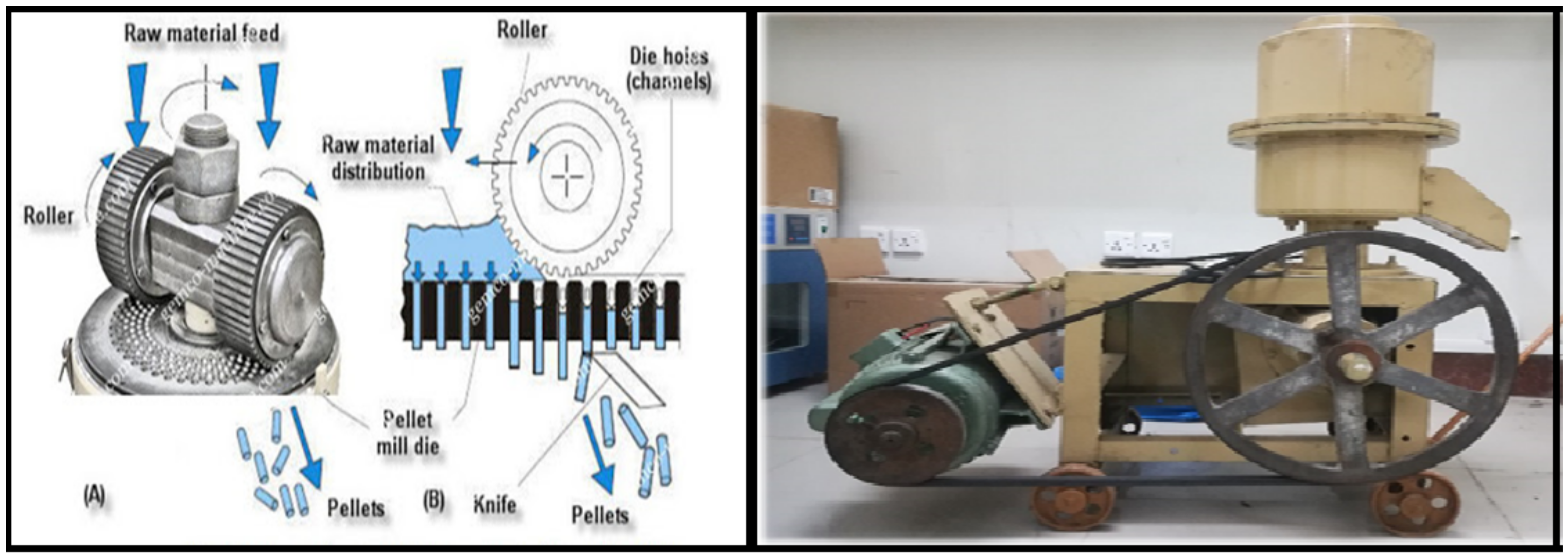

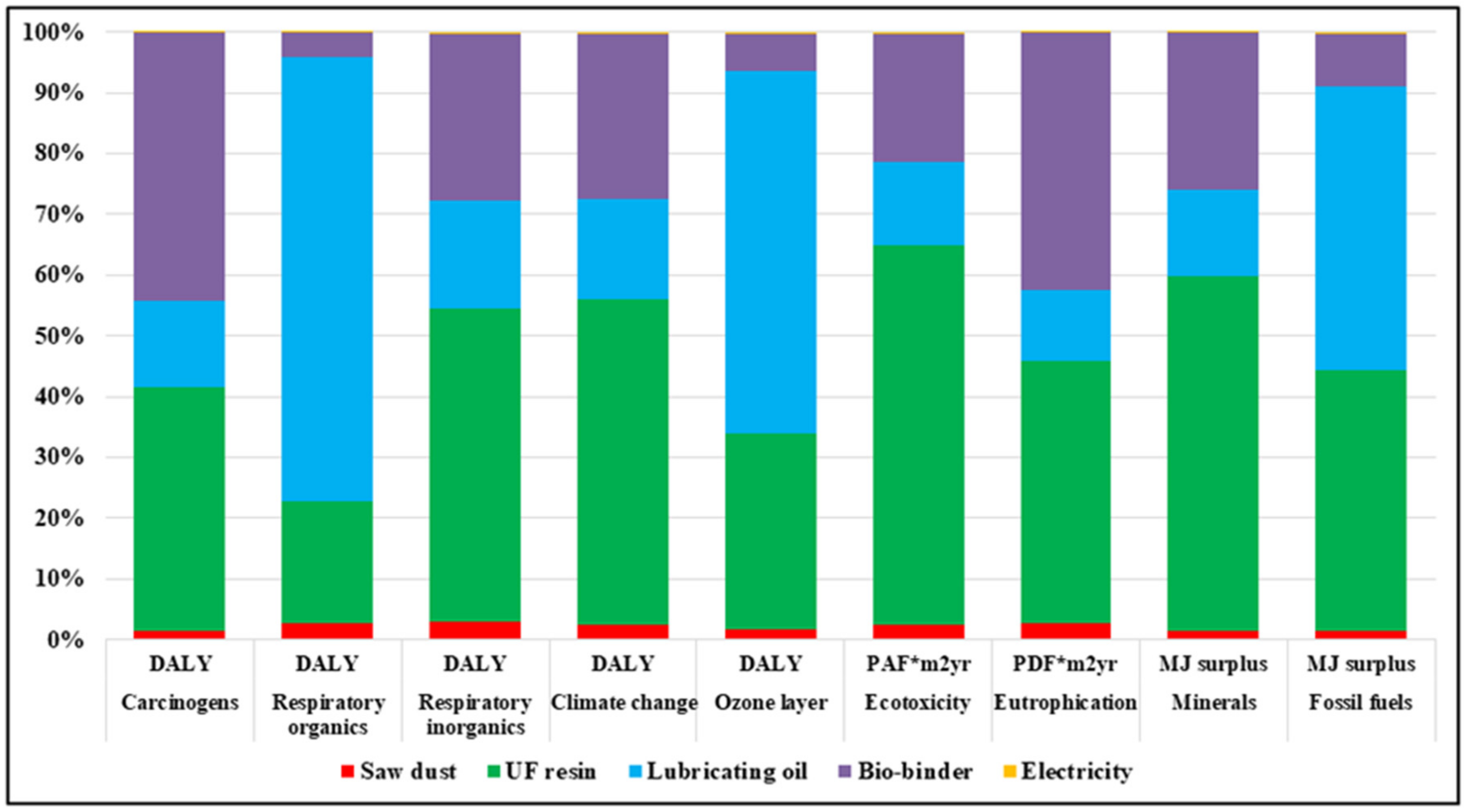
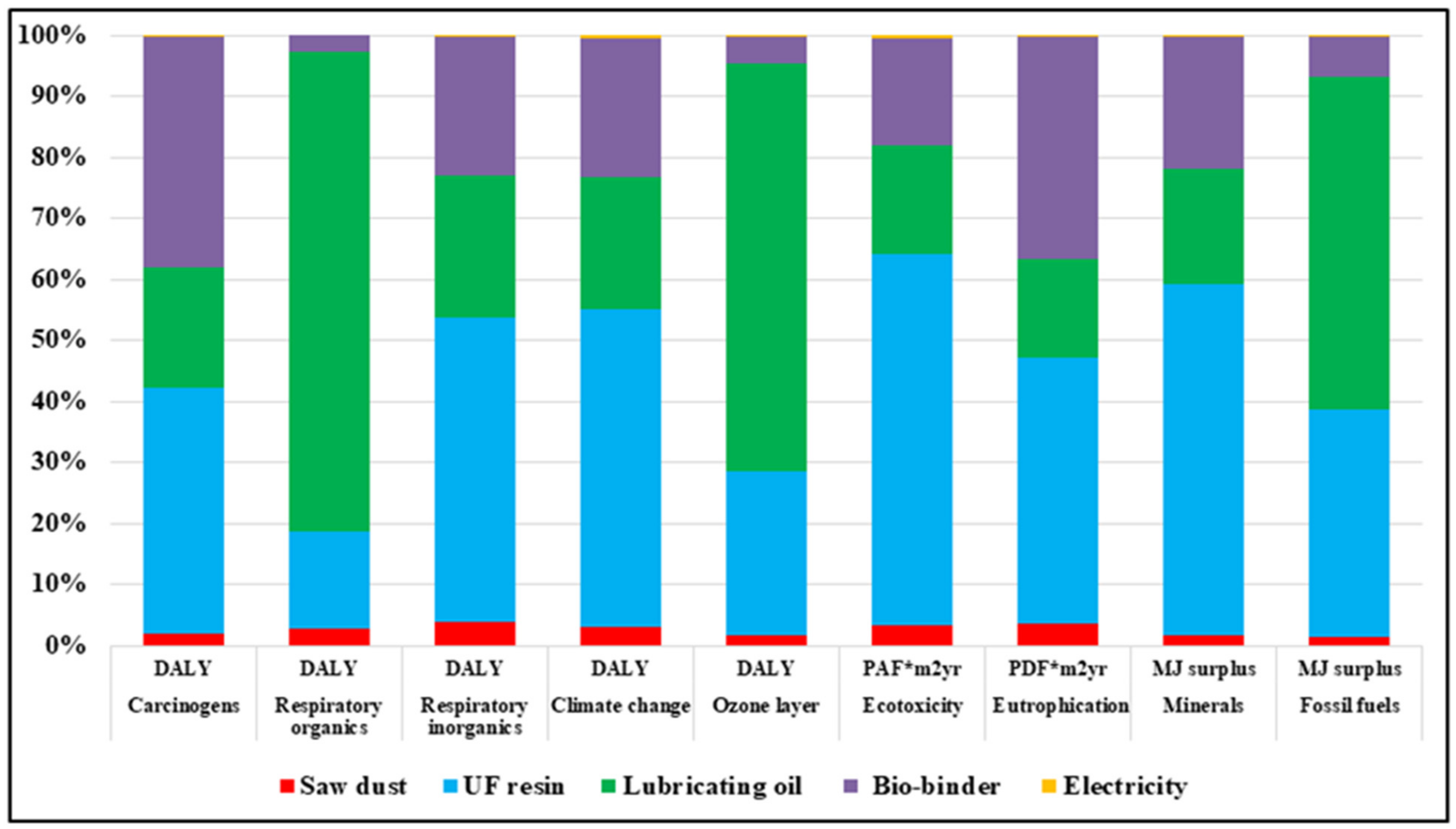
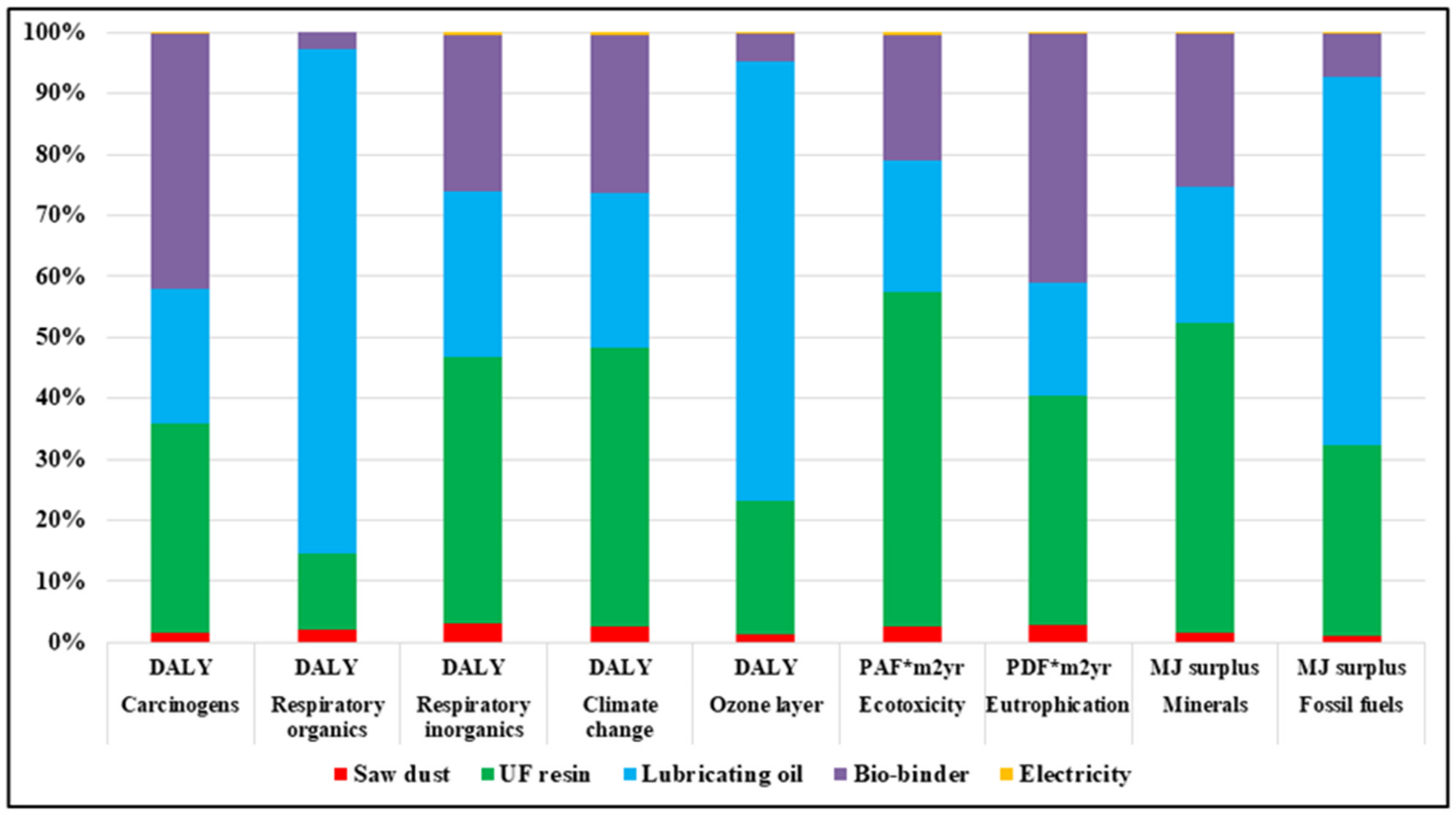
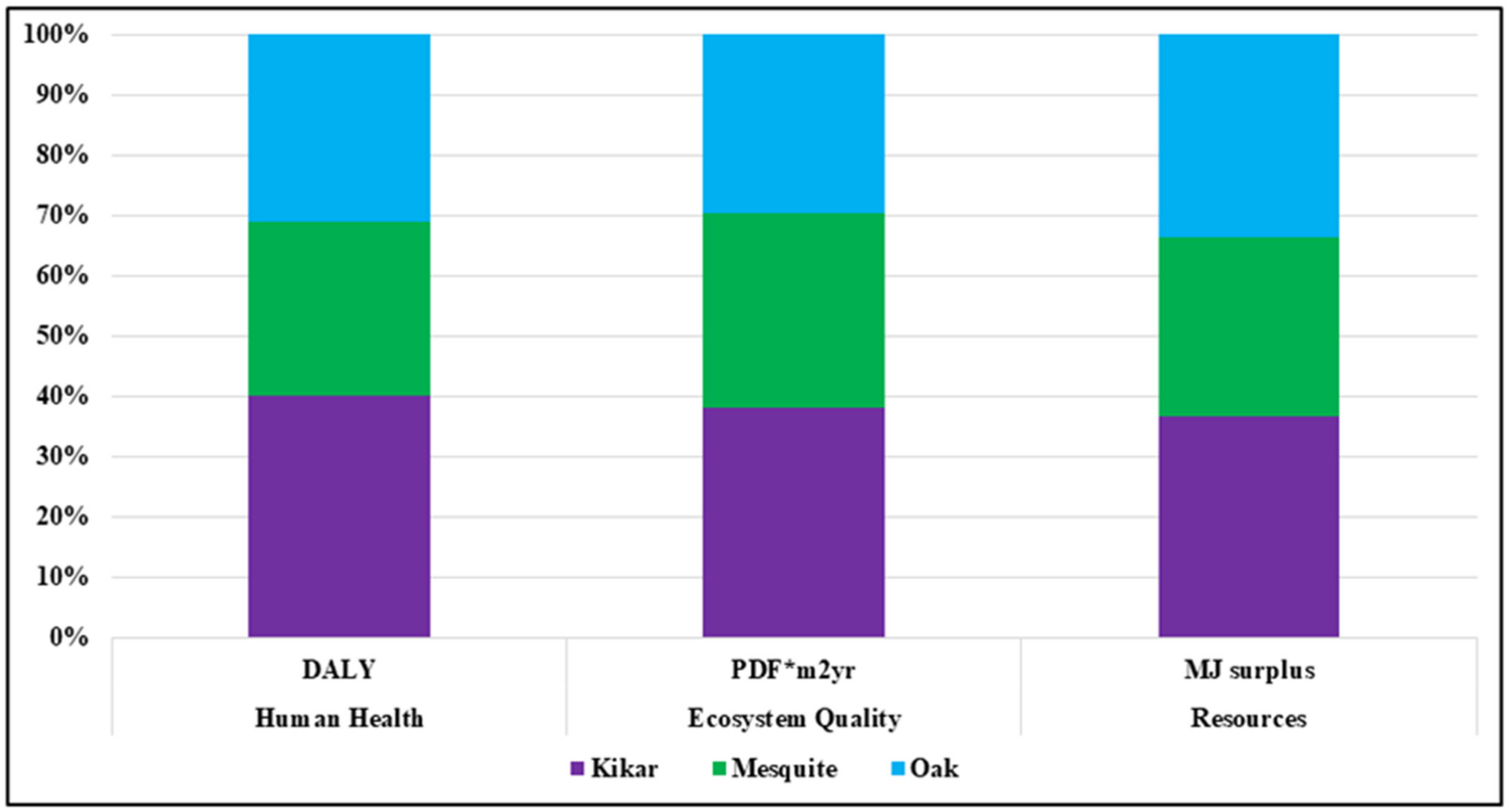
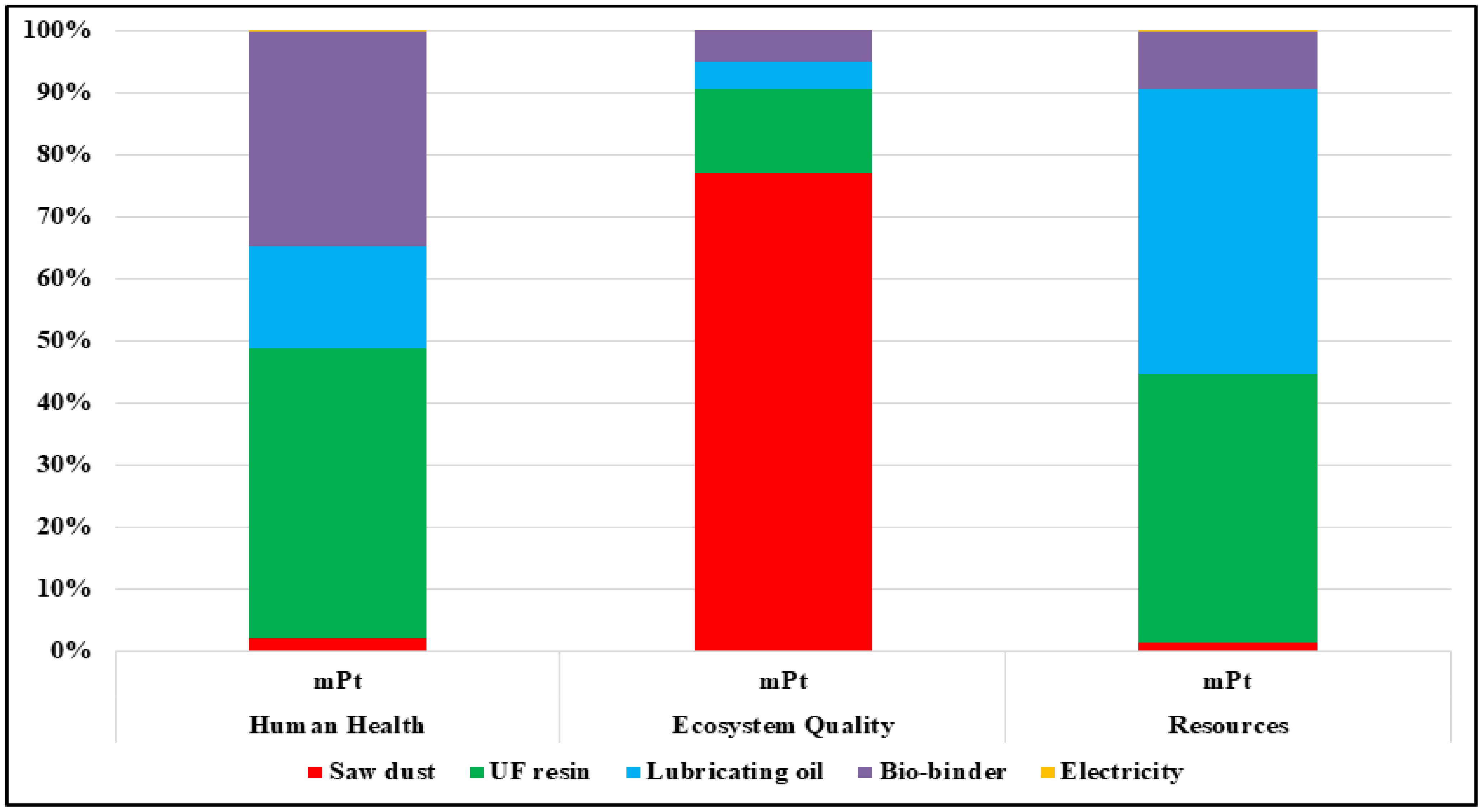
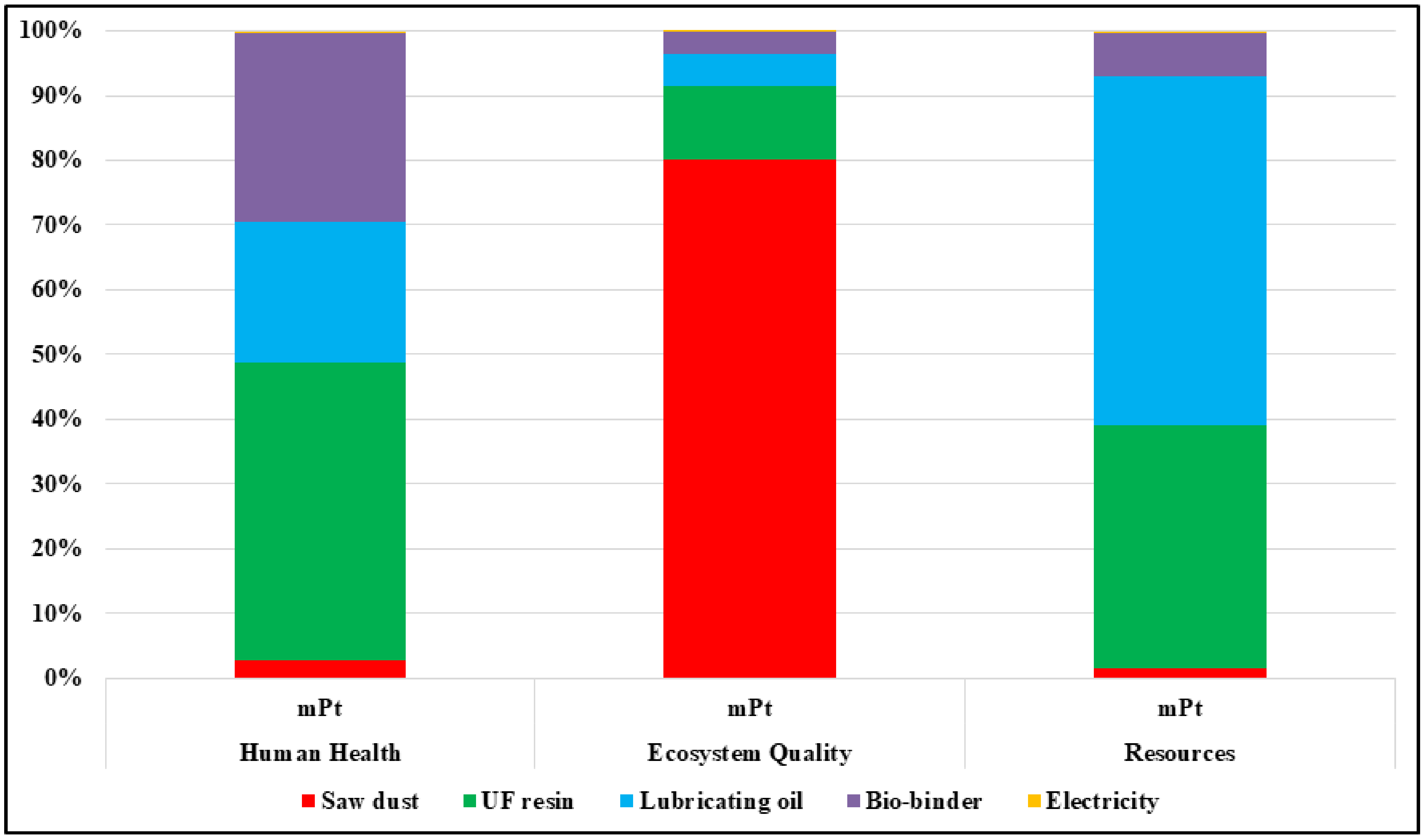

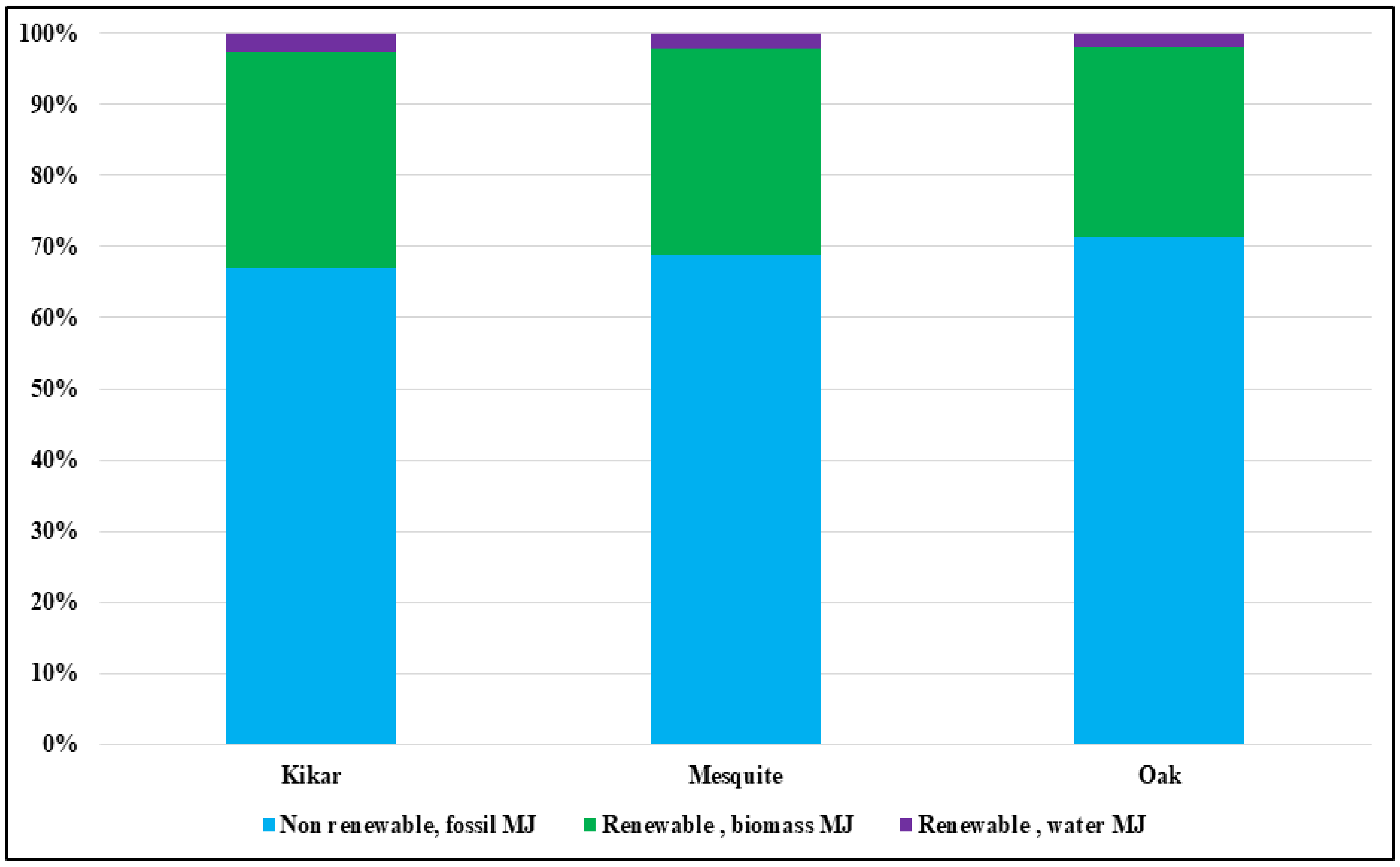
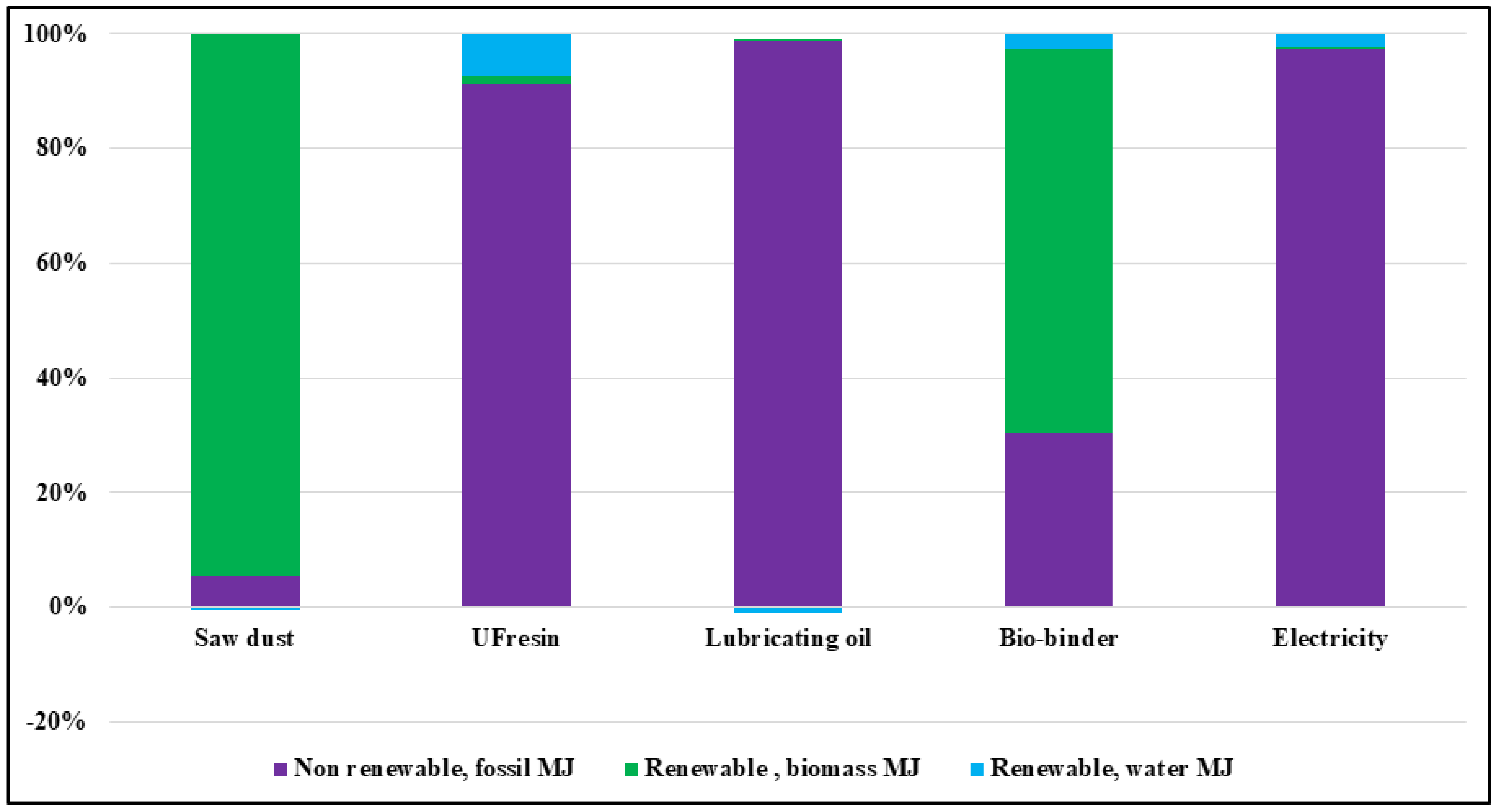


| Inputs | Unit | Mesquite Tree | Kikar Tree | Oak Tree |
|---|---|---|---|---|
| Saw dust use | gram (g) | 635 | 721 | 560 |
| Bio-binder | g | 136 | 225 | 165 |
| Glue (UF resin) use | g | 127 | 180 | 119 |
| Water use | Litre (L) | 0.470 | 0.555 | 0.508 |
| Lubricating oil use | g | 133 | 140 | 166 |
| Electricity consumed | (kilo-Watt-hour) kWh | 0.0046 | 0.0043 | 0.005 |
| Output | ||||
| Wood pellet produced | Kilogram (kg) | 1 | 1 | 1 |
| Characterization | Unit | Mesquite Tree | Kikar Tree | Oak Tree |
|---|---|---|---|---|
| Diameter | mm | 8.17 | 8.17 | 8.17 |
| Length | mm | 29.3 | 31.16 | 47.71 |
| Moisture content (MC) | wb/% | 8.8 | 7.9 | 7.8 |
| Ash content | % | 0.62 | 0.39 | 0.32 |
| Bulk Density | kg/dm3 | 590 | 560 | 360 |
| Nitrogen | % | 0.55 | 0.82 | 0.61 |
| Sulphur | % | 0.04 | 0.02 | 0.04 |
| High heating values (HHV) | MJ/kg | 21.87 | 23.10 | 21.14 |
| Low heating values (LHV) | MJ/kg | 20.13 | 21.32 | 19.00 |
| Name of Parameters | N | Mean | Standard Error | Standard Deviation | Variance |
|---|---|---|---|---|---|
| Diameter | 3 | 0.817 | 0.000 | 0.000 | 0.000 |
| Length | 3 | 3.605 | 0.585 | 1.013 | 1.027 |
| Moisture content | 3 | 8.166 | 0.317 | 0.550 | 0.303 |
| Bulk density | 3 | 0.503 | 0.072 | 0.125 | 0.016 |
| Ash content | 3 | 0.443 | 0.090 | 0.156 | 0.025 |
| HHV | 3 | 22.036 | 0.571 | 0.990 | 0.981 |
| LHV | 3 | 20.150 | 0.669 | 1.160 | 1.346 |
| Nitrogen | 3 | 0.660 | 0.081 | 0.141 | 0.020 |
| sulphur | 3 | 0.033 | 0.006 | 0.011 | 0.000 |
| Impact Category | Fossil Fuel Depletion | Ecotoxicity | Mineral Depletion | Acidification/Eutrophication |
|---|---|---|---|---|
| Unit | MJ Surplus | PAF.m2yr | MJ Surplus | PDF.m2yr |
| Baseline value of lubricating oil | 1.8752 | 0.4801 | 0.0464 | 0.0300 |
| 20% reduction in lubricating oil | 1.5222 | 0.3824 | 0.0369 | 0.0238 |
| Percent decrease in environmental impacts | 19% | 20% | 20% | 21% |
| Comparative environmental impacts assessment of wood pellets from baseline results with 20% reduction in UF resin | ||||
| Baseline value of UF resin | 1.8752 | 0.4801 | 0.0464 | 0.0300 |
| 20% reduction in UF resin | 1.5782 | 0.3493 | 0.0340 | 0.0225 |
| Percent decrease in environmental impacts | 16% | 27% | 27% | 25% |
| Comparative environmental impacts assessment of wood pellets from baseline results with 0% of UF resin | ||||
| Baseline Value | 1.8752 | 0.4801 | 0.0464 | 0.0300 |
| 0% of UF resin | 1.0751 | 0.1629 | 0.0170 | 0.0145 |
| Percent decrease in environmental impacts | 42% | 66% | 63% | 52% |
| Impact category | Human Health | Ecosystem Quality | Resource Depletion |
|---|---|---|---|
| Unit | DALY | PAF.m2yr | MJ Surplus |
| Baseline Value | 2.15 × 10−6 | 0.353 | 1.922 |
| 20% reduction in lubricating oil | 1.71 × 10−6 | 0.306 | 1.559 |
| Percent decrease in environmental impacts | 20% | 13% | 19% |
| Comparative damage assessment of wood pellets from baseline data with 20% reduction in UF resin | |||
| Baseline Value | 2.15 × 10−6 | 0.353 | 1.922 |
| 20% reduction in UF resin | 1.63 × 10−6 | 0.301 | 1.612 |
| Percent decrease in environmental impacts | 24% | 15% | 16% |
| Comparative damage assessment of wood pellets from baseline data with 0% of UF resin | |||
| Baseline Value | 2.15 × 10−6 | 0.353 | 1.922 |
| 0% of UF resin | 1.01 × 10−6 | 0.346 | 1.092 |
| Percent decrease in environmental impacts | 53% | 2% | 43% |
| Impact Category | Non Renewable, Fossil | Renewable, Biomass | Renewable, Water |
|---|---|---|---|
| Unit | MJ | MJ | MJ |
| Baseline Value | 23.925 | 10.859 | 0.935 |
| 20% reduction in lubricating oil | 19.430 | 9.086 | 0.735 |
| Percent decrease in environmental impacts | 18.79% | 16.33% | 21.40% |
| Comparative exergy of wood pellets from baseline data with 20% reduction in UF resin | |||
| Baseline Value | 23.925 | 10.859 | 0.935 |
| 20% reduction in UF resin | 20.227 | 9.074 | 0.587 |
| Percent decrease in environmental impacts | 15.46% | 16.44% | 37% |
| Comparative exergy of wood pellets from baseline data with 0% of UF resin | |||
| Baseline Value | 23.925 | 10.859 | 0.935 |
| Without useage of UF resin | 13.993 | 10.597 | 0.070 |
| Percent decrease in environmental impacts | 41.50% | 2.40% | 92.50% |
Publisher’s Note: MDPI stays neutral with regard to jurisdictional claims in published maps and institutional affiliations. |
© 2022 by the authors. Licensee MDPI, Basel, Switzerland. This article is an open access article distributed under the terms and conditions of the Creative Commons Attribution (CC BY) license (https://creativecommons.org/licenses/by/4.0/).
Share and Cite
Rashedi, A.; Muhammadi, I.U.; Hadi, R.; Nadeem, S.G.; Khan, N.; Ibrahim, F.; Hassan, M.Z.; Khanam, T.; Jeong, B.; Hussain, M. Characterization and Life Cycle Exergo-Environmental Analysis of Wood Pellet Biofuel Produced in Khyber Pakhtunkhwa, Pakistan. Sustainability 2022, 14, 2082. https://doi.org/10.3390/su14042082
Rashedi A, Muhammadi IU, Hadi R, Nadeem SG, Khan N, Ibrahim F, Hassan MZ, Khanam T, Jeong B, Hussain M. Characterization and Life Cycle Exergo-Environmental Analysis of Wood Pellet Biofuel Produced in Khyber Pakhtunkhwa, Pakistan. Sustainability. 2022; 14(4):2082. https://doi.org/10.3390/su14042082
Chicago/Turabian StyleRashedi, Ahmad, Irfan Ullah Muhammadi, Rana Hadi, Syeda Ghufrana Nadeem, Nasreen Khan, Farzana Ibrahim, Mohamad Zaki Hassan, Taslima Khanam, Byongug Jeong, and Majid Hussain. 2022. "Characterization and Life Cycle Exergo-Environmental Analysis of Wood Pellet Biofuel Produced in Khyber Pakhtunkhwa, Pakistan" Sustainability 14, no. 4: 2082. https://doi.org/10.3390/su14042082
APA StyleRashedi, A., Muhammadi, I. U., Hadi, R., Nadeem, S. G., Khan, N., Ibrahim, F., Hassan, M. Z., Khanam, T., Jeong, B., & Hussain, M. (2022). Characterization and Life Cycle Exergo-Environmental Analysis of Wood Pellet Biofuel Produced in Khyber Pakhtunkhwa, Pakistan. Sustainability, 14(4), 2082. https://doi.org/10.3390/su14042082







